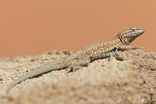This week saw the Reptile Monitoring Crews in Kansas, Oklahoma, and Colorado. Danny & Beth took a quick 2-day jaunt into Oklahoma to survey some newly-accessed land with one of the project volunteers, then looped through Kansas the remainder of the week. Celina & Devin also surveyed in Oklahoma for a few days prior to heading to two National Historic Sites the project recently gained access to in Colorado.
| Danny - "It was nice to be back in my home state for much of the week and become reacquainted with species not found further west. It was also one of the first really hot weeks this summer, and we expected to not see as many reptiles out active. Even with the heat, we were glad to find some critters out and about, mostly found in or near shade. I spotted my first two Slender Glass Lizards in many years this week - they are one of several legless lizard species found in North America (see photo above). We recorded a few other firsts for the project, including Northern Watersnake (albeit not a terrestrial 'target' species for this project), Common Gartersnakes, and a Great Plains Skink. I was also sent home with about 500 reminders that late July in the field can mean chiggers, mosquitoes, biting flies, and ticks are in full force in some areas! Volunteers in the eastern Plains should not forget their long pants and insect repellent!" | Beth - "Flipping through 'Ampibians, Reptiles, & Turtles in Kansas' I skimmed over the Slender Glass Lizard never expecting to actually see a species so strange in the wild. I was not expecting to be walking through grass taller than myself, rolling hills, or deciduous forest in Kansas either but I was. The Glass Lizard, legless and slender, looked like a snake on the road. Yet, this species is easily distinguished from snakes by the presence of an external ear opening and eyelids. When it went to move off the gravel, it wasn't nearly as fluid as a snake, more like a noodle being shocked into spurts of movement. This bizarre and striking reptile was definitely my favorite find from an awesome week in Kansas." |
| Devin - "This week Celina and I checked out some newly-accessed habitat in Oklahoma and southern Colorado. On one of the sites our first day of surveying there was a long stretch of river that ran through our survey plot. I decided to walk along the bank of this river with the hopes of finding a few garter snakes in my path. Although I didn't end up finding any garter snakes, I did find a ton of Plains Leopard Frogs and Bullfrogs, including some Bullfrogs that were as large as a dinner plate! There was also a beaver at the camp site that night which was a first for me!" | Celina - "A rare treat this week was a Plains Hog-nosed Snake, a species which I haven't encountered in about 3 years. Hog-nosed snakes are fossorial (live below ground surface) and tend to come out after rains, when their preferred prey item (toads) are also moving around and abundant. This individual was willing to let me take several voucher photographs before deciding he was done with my attentions, flattening out his head and neck to appear larger and intimidating but merely slowly slithering off back into the grass, giving a hiss back at me for trying to take more pictures of this display, and out of sight." |
 RSS Feed
RSS Feed
